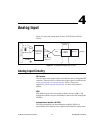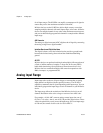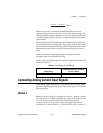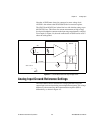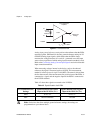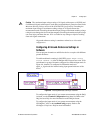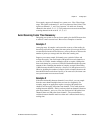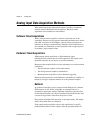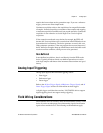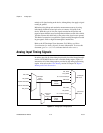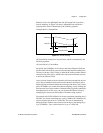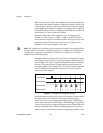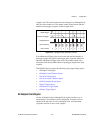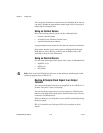Chapter 4 Analog Input
© National Instruments Corporation 4-9 NI 6238/6239 User Manual
For example, suppose all channels in a system use a –20 to 20 mA input
range. The signals on channels 0, 2, and 4 vary between 18 and 19 mA. The
signals on channels 1, 3, and 5 vary between –18 and 0 mA. Scanning
channels in the order 0, 2, 4, 1, 3, 5 will produce more accurate results than
scanning channels in the order 0, 1, 2, 3, 4, 5.
Avoid Scanning Faster Than Necessary
Designing your system to scan at slower speeds gives the PGIA more time
to settle to a more accurate level. Here are two examples to consider.
Example 1
Averaging many AI samples can increase the accuracy of the reading by
decreasing noise effects. In general, the more points you average, the more
accurate the final result will be. However, you may choose to decrease the
number of points you average and slow down the scanning rate.
Suppose you want to sample 10 channels over a period of 40 ms and
average the results. You could acquire 500 points from each channel at a
scan rate of 125 kS/s. Another method would be to acquire 1,000 points
from each channel at a scan rate of 250 kS/s. Both methods take the same
amount of time. Doubling the number of samples averaged (from 500 to
1,000) decreases the effect of noise by a factor of 1.4 (the square root of 2).
However, doubling the number of samples (in this example) decreases the
time the PGIA has to settle from 8 µs to 4 µs. In some cases, the slower scan
rate system returns more accurate results.
Example 2
If the time relationship between channels is not critical, you can sample
from the same channel multiple times and scan less frequently. For
example, suppose an application requires averaging 100 points from
channel 0 and averaging 100 points from channel 1. You could alternate
reading between channels—that is, read one point from channel 0, then one
point from channel 1, and so on. You also could read all 100 points from
channel 0 then read 100 points from channel 1. The second method
switches between channels much less often and is affected much less by
settling time.



